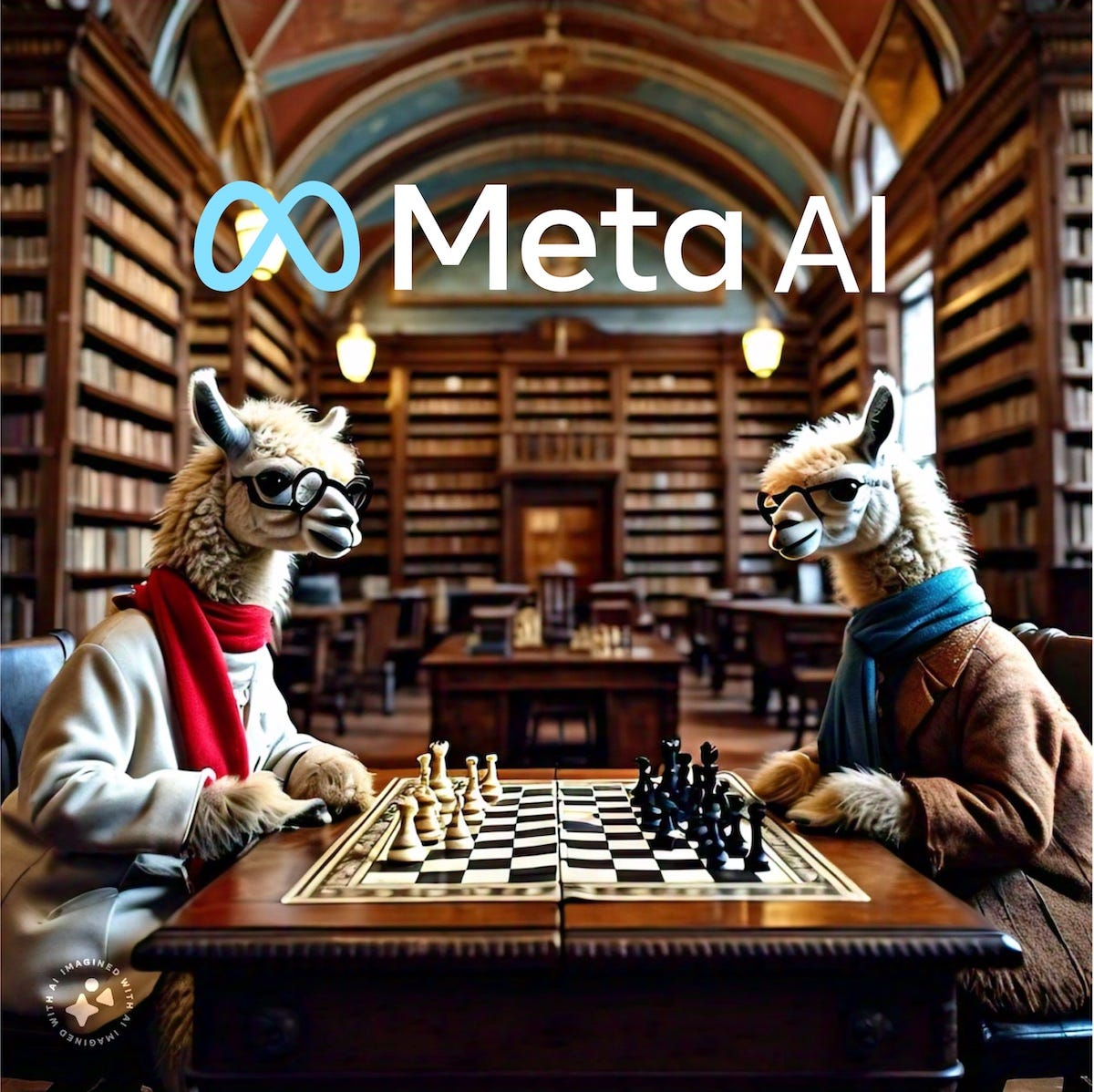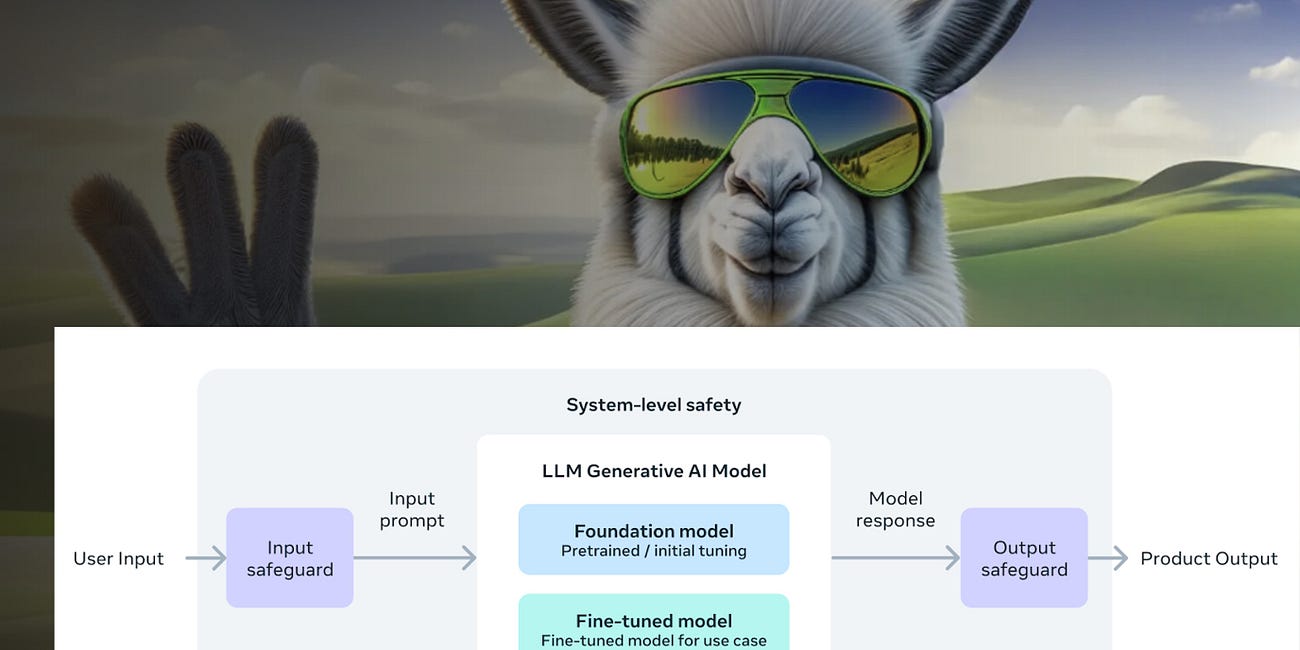Meta Llama 3 Launch Part 3 - Meta AI Upgrade, Broader Distribution & Strategy
The strategy behind Meta AI is now quite clear
Meta’s Llama 3 announcements (Part 1, Part 2) were coupled with broader availability for the new large language models (LLM) via the Meta AI assistant. This is now available in 14 countries via Meta’s social media apps and a new web app. According to the Meta AI announcement this week:
You can use Meta AI on Facebook, Instagram, WhatsApp and Messenger…We’re rolling out Meta AI in English in more than a dozen countries outside of the US. Now, people will have access to Meta AI in Australia, Canada, Ghana, Jamaica, Malawi, New Zealand, Nigeria, Pakistan, Singapore, South Africa, Uganda, Zambia and Zimbabwe.
…
We want Meta AI to be available when you’re trying to get things done at your computer too, so we’re rolling out meta.ai (the website) today.
This is an important upgrade for Meta. Its original AI assistant version employed the Llama 2 70B model and was relatively good, but it clearly trailed offerings from OpenAI and Google for many use cases. The upgrade to Llama 3 70B will close the gap between GPT-3.5 and Gemini Pro experiences, the comparable free offerings from OpenAI for ChatGPT and Google for Gemini.
Synthedia expects the new 400B (or maybe it’s really 405B based on Meta CEO Mark Zuckerberg's comments) to be made available to paid users and through Quest VR goggles when it launches later this year. That should bring the performance closer to ChatGPT Plus with GPT-4 and Gemini Advanced with the Ultra model, though it may not match the forthcoming GPT-5.
Regardless, Meta’s latest offerings position the company as a solid competitor in the new generative AI consumer assistant category. Its massive distribution, loyal daily user base across social media apps, and personalization information may, in fact, offer it advantages that OpenAI cannot match.
This is bad news for Google, which is fighting to establish itself as the key alternative to OpenAI in the generative AI foundation model and personal assistant segments. Meta’s upgrades could complicate those efforts.
Create Images
In addition to chat, Meta AI can now create images. Meta’s research teams have produced several impressive text-to-image and text-to-video models. Today, you can create images and animate them as gifs. Marketing materials distributed to reporters suggest that users can also make videos using text inputs. However, the written materials only refer to images and gifs. So, this might be a feature that will be released in the future.
In-App and X-App Search
Users of Facebook, Instagram, Messenger, and WhatsApp can tap into Meta AI to search across Meta’s app ecosystem and the web. This provides an opportunity to access a broader set of data than you can typically access through other generative AI apps. Internet search is supplied through integrations with both Microsoft Bing and Google Search.
Meta AI on the Web
The Meta.ai website is an interesting concession from Meta. The company has billions of users across its app ecosystem. Typically, it wants to funnel users to these apps. Meta AI as an embedded assistant provides added value in the context of those apps. However, the company must realize that Meta AI presents an opportunity to engage users who are not loyal to the company’s existing apps or who typically think of an assistant as serving a different role and context than social media and messaging.
Meta AI on the web removes a potential barrier to adoption and suggests the strategy is not simply a hook to bring users back to its social media apps but should be viewed as valuable on its own merit.
The experience is very similar to ChatGPT, with a left sidebar that lists previous chats and enables selecting between text and image features. It also has a center-screen prompt dialogue box.
Privacy
You can use the text-enabled features anonymously, but you must sign into Facebook to use the text-to-image capabilities and see previous chats.
In order to use Meta AI anonymously or using an existing account, you need to accept Meta’s terms and privacy policy from your region. In addition, there is a note that includes a default requirement that “Meta may use your AI messages to improve quality.” It says that “Personal messages are never sent to Meta,” but it is unclear how they are used to improve AI models without somehow arriving on Meta servers.
Every generative AI solution requires users to accept terms of some sort, so Meta’s approach is not unique. However, this has been a sticking point for Meta over the years and could be a barrier to enlisting some new users. Meta’s terms state that the company does not sell personal information to advertisers, but it does not apply that same restriction to its own use.
Meta’s Generative AI Strategy
Meta AI is the embodiment of several elements of Meta’s broader generative AI strategy. Consider the following:
Don’t get disintermediated—Meta AI is designed as an alternative for the Meta app ecosystem, so users don’t feel compelled to leave and employ an OpenAI, Google, or Microsoft solution when they want access to a generative AI assistant or robust search functionality. Meta doesn’t want other apps to become top-of-mind or first-point-of-contact for consumers.
Use the distribution—Meta’s apps provide the broadest distribution for an assistant of any global company, with four billion monthly active users. That is a powerful springboard to drive the adoption of a generative AI-enabled assistant in a market in the early stages of development where user loyalties are far from settled.
Build vs buy—Apple is considering adopting Google Gemini for some generative AI-enabled features on the iPhone. However, Meta does not expect to get paid by Google for using its service, particularly at the scale of its operation. Meta could not afford to be in a position where it would have to pay for generative AI services because the costs would be too significant. That is a key reason why Meta was willing to invest in building AI foundation models and acquire more than 10 billion dollars in NVIDIA GPUs. Finally, it wants to control its future as the market develops and reduce dependence on industry rivals.
Integrated platform—Also, remember that Meta has hardware platforms in the Quest VR goggles and Meta RayBan smart glasses. These platforms either rely on or heavily benefit from voice interaction capabilities. Meta AI as a conversational interface can enable these features across hardware platforms to offer hands-free experiences.
Personalization vs. Information—Meta’s apps are mostly about people, their likes, and connections. Other generative AI apps are about information. If Meta employed a partner, it might inadvertently give away valuable information about people. Using an in-house solution enables Meta to protect the company’s competitive advantage and provide more personalization than alternatives.
Added value—Meta has been working to counteract user erosion and declining use frequency in the U.S. and other high-value markets. These issues are often attributed to the rise of TikTok, but there is also a perceived staleness of the long-standing offerings. The Meta AI assistant could potentially serve as a desirable feature that would retain existing app users and potentially bring other users back to more regular use.
Let me know what you think about Meta AI. While the introduction of Meta AI with celebrity-inspired personalities last year was mostly a novelty, the upgraded Meta AI is more directly competitive with other generative AI assistant offerings. It is also central to Meta’s ongoing strategy.
Meta Llama 3 Launch Part 1 - 8B and 70B Models are Here, with 400B Model Coming
Meta launched the Llama 3 large language model (LLM) today in 8B and 70B parameter sizes. Both models were trained on 15 trillion tokens of data and are released under a permissive commercial and private use license. The license is not as permissive as traditional open-source options, but its restrictions are limited.
Meta Llama 3 Launch Part 2 - New Model Security and Performance Benchmarks
The biggest Llama 3 announcements were around the updated foundation models. However, Meta also made several other announcements of significance. These include the expanded availability of Meta AI (coming in Part 3 of this series), along with a new performance benchmark and cybersecurity evaluation suite for large language models (LLM).









"Meta’s apps provide the broadest distribution for an assistant of any global company, with four billion monthly active users."
Meta's potential for user adoption is unparalleled, but it will also lead to ballooning inference costs. At the same time, Meta is giving away Llama 3 for free choosing not to charge for usage through API access. What is Meta's endgame here? Where is the money going to be made and when will they start capitalizing?